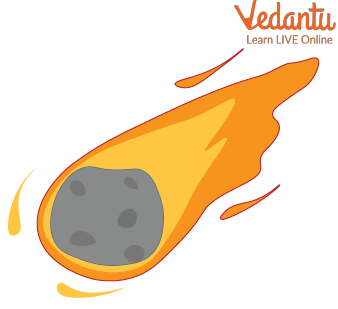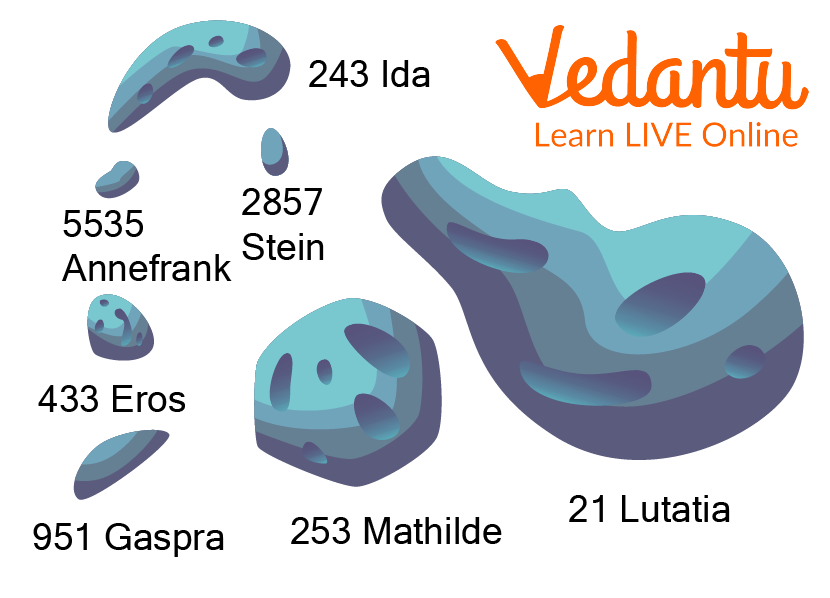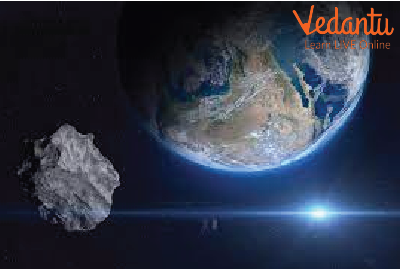




What Are Asteroids? Definition, Types, and Real-Life Examples Explained
We are going to learn about a very interesting topic: asteroids. Asteroids, sometimes known as minor planets, are stony byproducts of the early solar system formation, which took place approximately 4.6 billion years ago. There are 1,113,527 known asteroids as of now. The main asteroid belt, which is located among Mars and Jupiter and orbits our Sun, contains the majority of this old space debris.
The asteroids also rotate, occasionally rather wildly, tumbling as they go through their elliptical orbits, around the Sun. Asteroids range in size from rocks under 1 metre across to nearly 1000 kilometres for the largest. Asteroids may have provided the early Earth with the materials required to start life. In this article, we will discuss the definition of an asteroid, the size and facts about asteroids and where asteroids come from.

Asteroids
Definition of Asteroid
Asteroids are tiny planets that fall outside of the category of a planet or a comet. These are typically found in the inner solar system, commonly known as the straight orbit around the Sun. Planetoids are another name for the larger varieties of asteroids. These are distinct from the outer solar system's minor planets in that they have surfaces made of volatile material, much like comets. These are commonly referred to as the asteroid belt.
Size of Asteroids
Asteroids can range in size from 1000 km to 10 metres. The three largest asteroids have distinct interiors despite having a nearly spherical form resembling a little planet. However, the majority of them are small and have atypical shapes. The asteroids are divided into three primary groups: C type, S type, and M type, according to their chemical components, which include their carbon content, metal composition, and silicate content.

Different Sizes of Asteroids
Facts of Asteroids
The following are some common asteroid facts:
Italian astronomer Giuseppe Piazzi made the initial asteroid discovery in 1801.
It is known as Ceres and has a diameter of roughly 950 kilometres. It is now considered a dwarf planet.
The designation of dwarf planet was granted to Ceres, Pluto, Eris, Makemake, and Haumea in 2006. Since the first asteroids were found, technology for finding them has advanced significantly, and astronomers now have access to a wide range of powerful telescopes to help with their studies and discoveries.
Where Do Asteroids Come from?
Our solar system's formation has left behind asteroids. When a large cloud of gas and dust imploded, our solar system came into being some 4.6 billion years ago. When this occurred, the majority of the material dropped to the cloud's core and created the Sun. In the cloud, a few of the condensing ducts developed into planets. The asteroids in the belt never got the chance to develop into planets. They are remains from the long-ago period when planets were forming.

Asteroid Image from NASA
Do Asteroids Differ in Any Way?
Yes! No two asteroids are alike since they formed in various places at various distances from the Sun. They are different in the following ways:
Unlike planets, asteroids are not circular. Their shapes are erratic and jagged.
Many asteroids are smaller than pebbles, yet some have diameters of hundreds of kilometres.
The majority of asteroids are composed of various types of rocks, although some also contain clays or metals like nickel and iron.
How Can Asteroids Teach Us Something?
Asteroids may teach scientists a lot about the formation of planets and the Sun because they developed at the same time as other solar system objects. Asteroids have also been flown by and studied by numerous NASA space missions. The OSIRIS-REx spacecraft was launched by NASA in 2016 to investigate the asteroid Bennu, which is close to the Earth. After several years of research on Bennu, OSIRIS-REx collected a sample of pebbles and dust from the asteroid's surface.
Summary
Small things in the Solar System are called asteroids that revolve around the Sun. They are made of metal and rock and may contain biological materials. Asteroids and comets are similar, but asteroids lack comets' observable coma (fuzzy outline and tail). Asteroids range in size from rocks under 1 metre across to nearly 1000 kilometres for the largest. The three largest resemble small planets in that they are nearly spherical, contain interiors that are at least partially differentiated, and are believed to be still-existing protoplanets.
FAQs on Asteroids: Complete Guide for Students
1. What is an asteroid as explained in EVS?
An asteroid is a small, rocky body that orbits the Sun. Think of them as leftover building materials from when our solar system was formed about 4.6 billion years ago. They are much smaller than planets and are often called minor planets. Most asteroids have irregular shapes because they do not have enough gravity to pull themselves into a round sphere like Earth or Mars.
2. What are asteroids made of?
The composition of asteroids varies, but they are generally made of rock, metals, and other minerals. Depending on their type, they can be rich in carbon, stone (silicates), or metallic iron and nickel. These materials are the same ones that formed the planets, which is why scientists are so interested in studying them.
3. Where is the asteroid belt located in our solar system?
The main asteroid belt is a large, ring-shaped region located in the vast space between the orbits of the planets Mars and Jupiter. This area is home to millions of asteroids, ranging in size from tiny pebbles to giant objects hundreds of kilometres across. The largest object in the belt is the dwarf planet Ceres.
4. What are the main types of asteroids?
Asteroids are primarily classified into three main types based on their composition:
C-type (Chondrite): These are the most common type, making up over 75% of known asteroids. They are very dark and are composed of clay and silicate rocks.
S-type (Stony): These asteroids are made of silicate materials and nickel-iron. They are brighter and are commonly found in the inner asteroid belt.
M-type (Metallic): These are composed mostly of metallic nickel and iron. They are remnants of the metallic cores of larger asteroids that were destroyed long ago.
5. What is the difference between an asteroid, a comet, and a meteor?
It's easy to confuse these space objects. Here’s a simple breakdown of their differences:
Asteroids: Are rocky and metallic objects that orbit the Sun and have no atmosphere or tail.
Comets: Are made of ice, dust, and rock. When they approach the Sun, the ice heats up and turns to gas, forming a glowing head (coma) and a long tail.
Meteors: Are the streaks of light we see, often called “shooting stars.” They occur when a small piece of an asteroid or comet (a meteoroid) enters Earth's atmosphere and burns up due to friction.
6. Why is the asteroid belt located between Mars and Jupiter and not somewhere else?
The location of the asteroid belt is due to the powerful gravitational influence of the planet Jupiter, the largest planet in our solar system. During the early days of the solar system, Jupiter's massive gravity stirred up the objects in this region, preventing them from collecting together to form a single, large planet. Instead, they remained as smaller, separate bodies, forming the belt we see today.
7. Why is it important for scientists to study asteroids?
Studying asteroids is very important for several reasons:
Understanding Solar System Formation: Since asteroids are ancient leftovers, they provide valuable clues about the conditions and materials that existed when our solar system was born.
Planetary Defence: By tracking the orbits of asteroids near Earth, scientists can identify any potential impact threats and develop ways to protect our planet.
Future Resources: Asteroids contain water and valuable minerals, which could one day be mined and used for building structures or providing fuel for missions in space.
8. Can an asteroid have its own moon?
Yes, surprisingly, some large asteroids have enough gravity to capture smaller asteroids, which then orbit them like a moon. These are known as binary asteroids or asteroid-moon systems. The first such moon, named Dactyl, was discovered in 1993 orbiting the larger asteroid Ida. This discovery showed that our solar system is more complex than previously thought.
9. How do scientists discover and track new asteroids?
Scientists use powerful ground-based and space telescopes to scan the sky for new objects. They take multiple images of the same patch of sky over several hours or days. They then use computers to compare these images and look for any points of light that have moved against the background of stationary stars. Once a potential asteroid is found, its path is observed carefully to calculate its orbit, size, and speed.









